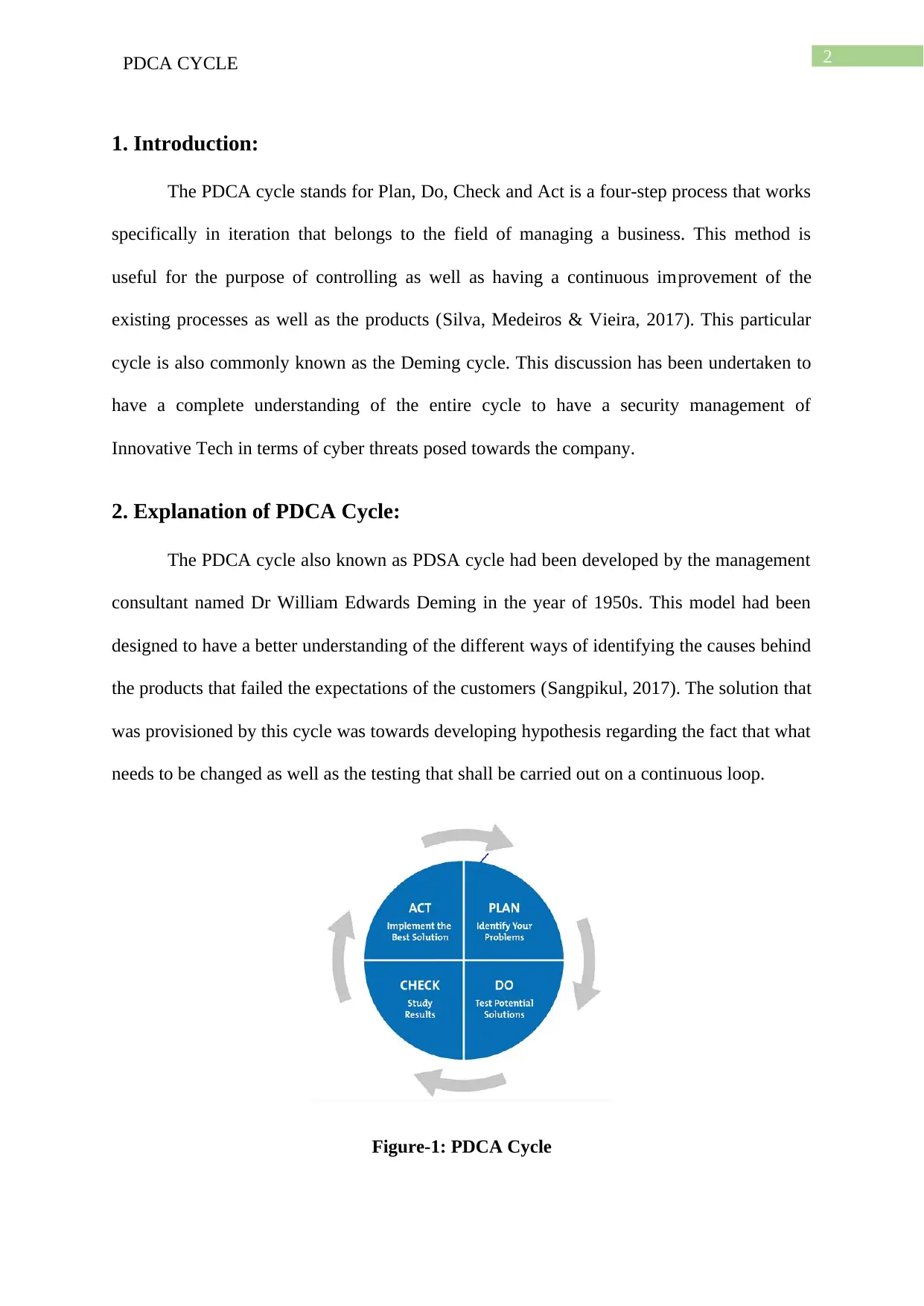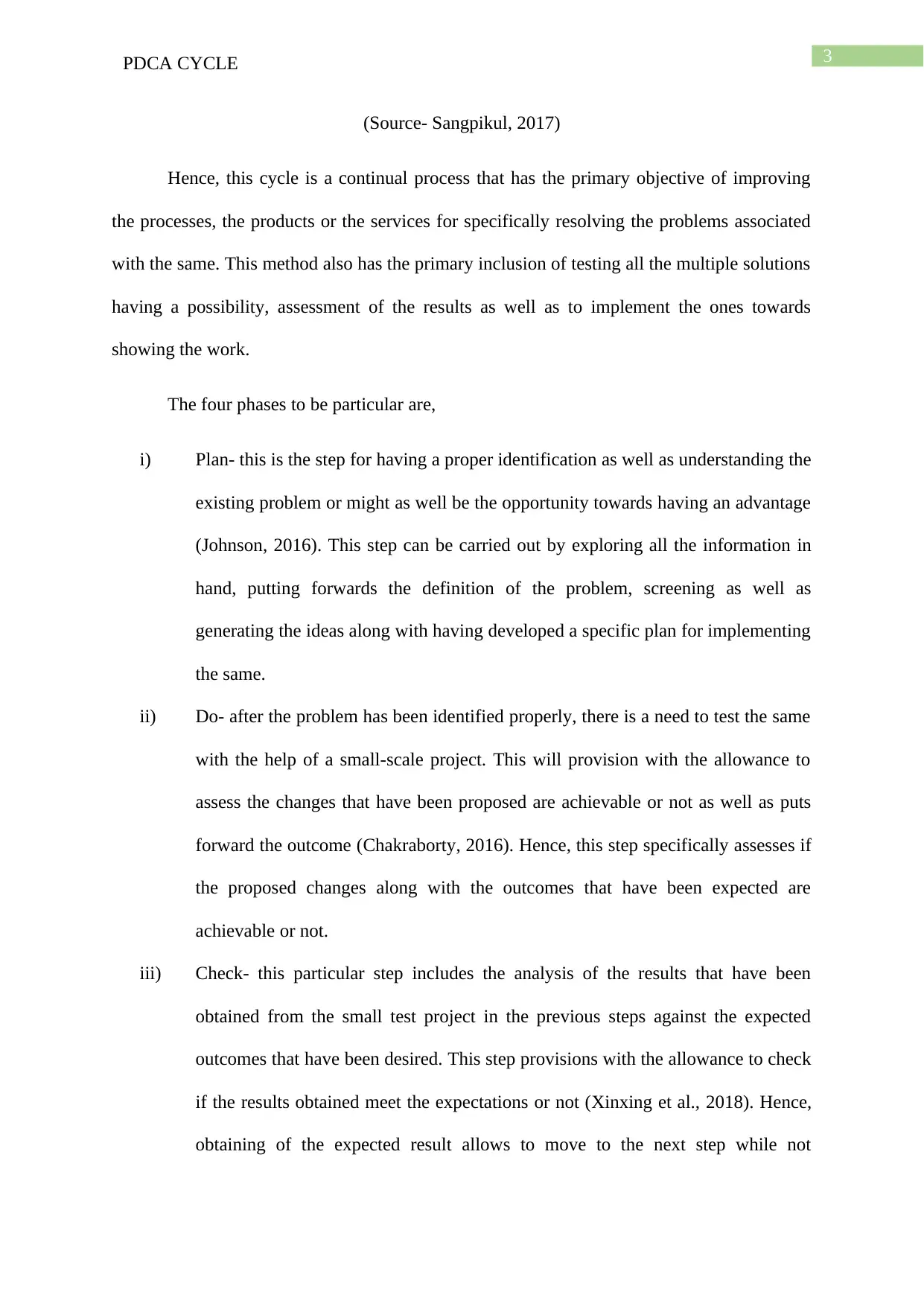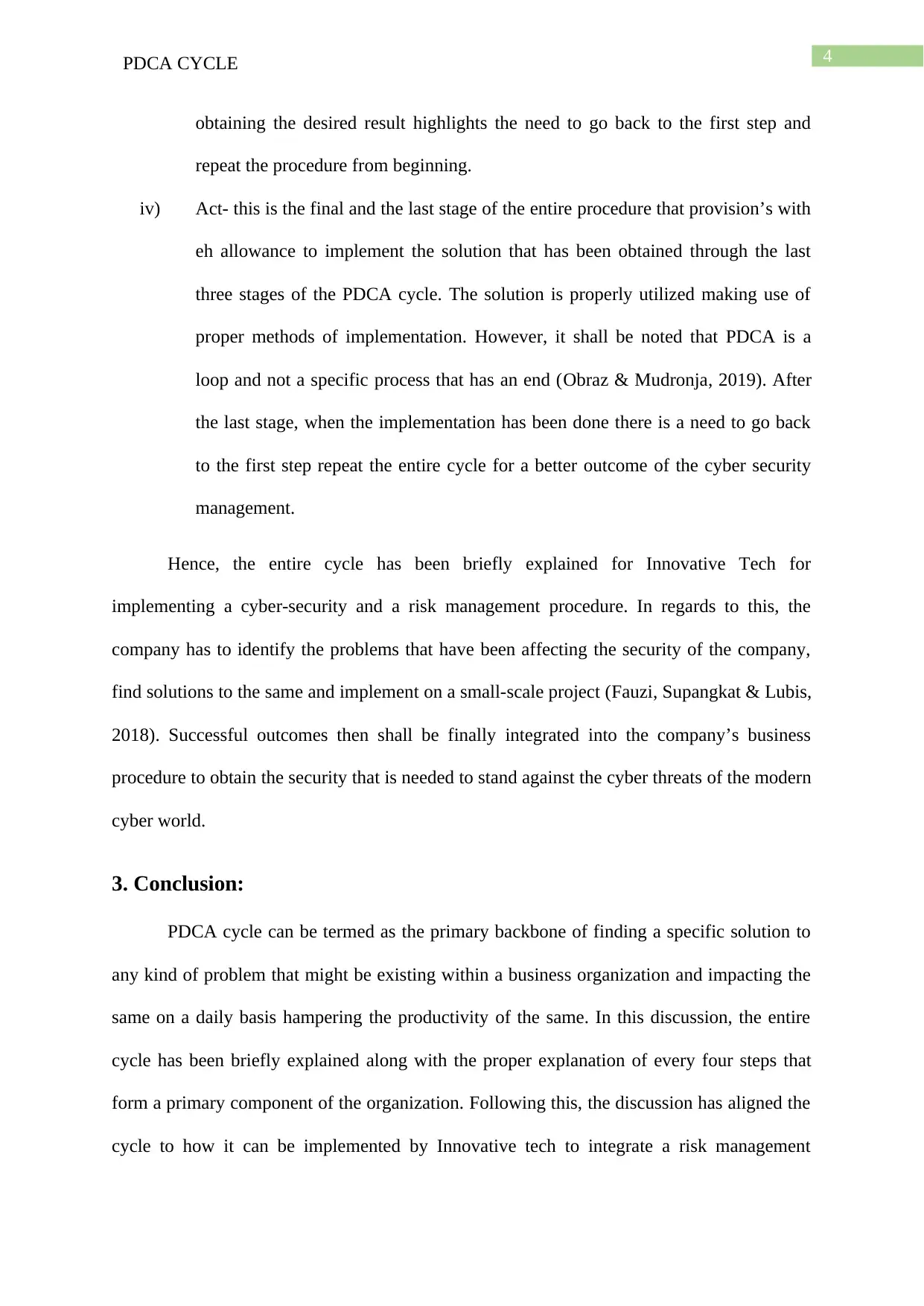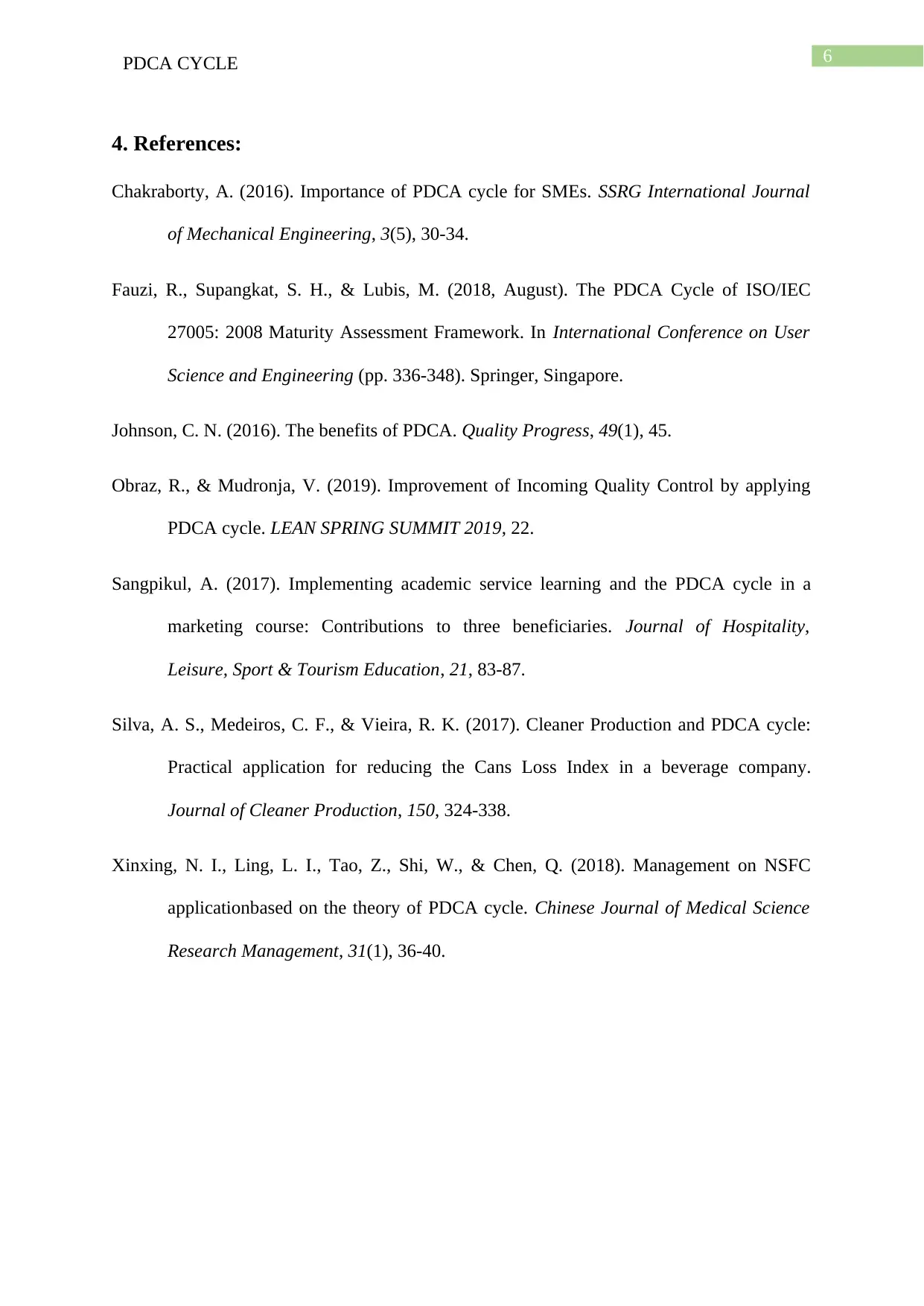Assessment of Cyber Security Strategies using the PDCA Cycle
VerifiedAdded on 2022/09/12
|7
|1203
|36
Report
AI Summary
This report delves into the application of the PDCA (Plan-Do-Check-Act) cycle for enhancing cyber security and risk management strategies at Innovative Tech. It begins with an introduction to the PDCA cycle, explaining its four iterative steps: planning, implementation, evaluation, and action, highlighting its role in continuous improvement of processes and products. The report then details each step of the cycle, providing a framework for identifying problems, developing solutions, testing them on a small scale, evaluating the results, and finally, implementing the successful solutions company-wide to strengthen Innovative Tech's cyber security posture. The analysis aligns the PDCA cycle with the company's need to address cyber threats and integrate risk management, emphasizing the importance of continual repetition of the cycle to adapt to evolving security challenges. The report concludes by underscoring the PDCA cycle's significance as a fundamental tool for problem-solving and its effective application in achieving desired outcomes in cyber security management.

Running head: - PDCA CYCLE
PDCA CYCLE
Name of the Student
Name of the University
Author Note
PDCA CYCLE
Name of the Student
Name of the University
Author Note
Paraphrase This Document
Need a fresh take? Get an instant paraphrase of this document with our AI Paraphraser

1PDCA CYCLE
Table of Contents
1. Introduction:...........................................................................................................................2
2. Explanation of PDCA Cycle:.................................................................................................2
3. Conclusion:............................................................................................................................4
4. References:.............................................................................................................................5
Table of Contents
1. Introduction:...........................................................................................................................2
2. Explanation of PDCA Cycle:.................................................................................................2
3. Conclusion:............................................................................................................................4
4. References:.............................................................................................................................5

2PDCA CYCLE
1. Introduction:
The PDCA cycle stands for Plan, Do, Check and Act is a four-step process that works
specifically in iteration that belongs to the field of managing a business. This method is
useful for the purpose of controlling as well as having a continuous improvement of the
existing processes as well as the products (Silva, Medeiros & Vieira, 2017). This particular
cycle is also commonly known as the Deming cycle. This discussion has been undertaken to
have a complete understanding of the entire cycle to have a security management of
Innovative Tech in terms of cyber threats posed towards the company.
2. Explanation of PDCA Cycle:
The PDCA cycle also known as PDSA cycle had been developed by the management
consultant named Dr William Edwards Deming in the year of 1950s. This model had been
designed to have a better understanding of the different ways of identifying the causes behind
the products that failed the expectations of the customers (Sangpikul, 2017). The solution that
was provisioned by this cycle was towards developing hypothesis regarding the fact that what
needs to be changed as well as the testing that shall be carried out on a continuous loop.
Figure-1: PDCA Cycle
1. Introduction:
The PDCA cycle stands for Plan, Do, Check and Act is a four-step process that works
specifically in iteration that belongs to the field of managing a business. This method is
useful for the purpose of controlling as well as having a continuous improvement of the
existing processes as well as the products (Silva, Medeiros & Vieira, 2017). This particular
cycle is also commonly known as the Deming cycle. This discussion has been undertaken to
have a complete understanding of the entire cycle to have a security management of
Innovative Tech in terms of cyber threats posed towards the company.
2. Explanation of PDCA Cycle:
The PDCA cycle also known as PDSA cycle had been developed by the management
consultant named Dr William Edwards Deming in the year of 1950s. This model had been
designed to have a better understanding of the different ways of identifying the causes behind
the products that failed the expectations of the customers (Sangpikul, 2017). The solution that
was provisioned by this cycle was towards developing hypothesis regarding the fact that what
needs to be changed as well as the testing that shall be carried out on a continuous loop.
Figure-1: PDCA Cycle
⊘ This is a preview!⊘
Do you want full access?
Subscribe today to unlock all pages.

Trusted by 1+ million students worldwide

3PDCA CYCLE
(Source- Sangpikul, 2017)
Hence, this cycle is a continual process that has the primary objective of improving
the processes, the products or the services for specifically resolving the problems associated
with the same. This method also has the primary inclusion of testing all the multiple solutions
having a possibility, assessment of the results as well as to implement the ones towards
showing the work.
The four phases to be particular are,
i) Plan- this is the step for having a proper identification as well as understanding the
existing problem or might as well be the opportunity towards having an advantage
(Johnson, 2016). This step can be carried out by exploring all the information in
hand, putting forwards the definition of the problem, screening as well as
generating the ideas along with having developed a specific plan for implementing
the same.
ii) Do- after the problem has been identified properly, there is a need to test the same
with the help of a small-scale project. This will provision with the allowance to
assess the changes that have been proposed are achievable or not as well as puts
forward the outcome (Chakraborty, 2016). Hence, this step specifically assesses if
the proposed changes along with the outcomes that have been expected are
achievable or not.
iii) Check- this particular step includes the analysis of the results that have been
obtained from the small test project in the previous steps against the expected
outcomes that have been desired. This step provisions with the allowance to check
if the results obtained meet the expectations or not (Xinxing et al., 2018). Hence,
obtaining of the expected result allows to move to the next step while not
(Source- Sangpikul, 2017)
Hence, this cycle is a continual process that has the primary objective of improving
the processes, the products or the services for specifically resolving the problems associated
with the same. This method also has the primary inclusion of testing all the multiple solutions
having a possibility, assessment of the results as well as to implement the ones towards
showing the work.
The four phases to be particular are,
i) Plan- this is the step for having a proper identification as well as understanding the
existing problem or might as well be the opportunity towards having an advantage
(Johnson, 2016). This step can be carried out by exploring all the information in
hand, putting forwards the definition of the problem, screening as well as
generating the ideas along with having developed a specific plan for implementing
the same.
ii) Do- after the problem has been identified properly, there is a need to test the same
with the help of a small-scale project. This will provision with the allowance to
assess the changes that have been proposed are achievable or not as well as puts
forward the outcome (Chakraborty, 2016). Hence, this step specifically assesses if
the proposed changes along with the outcomes that have been expected are
achievable or not.
iii) Check- this particular step includes the analysis of the results that have been
obtained from the small test project in the previous steps against the expected
outcomes that have been desired. This step provisions with the allowance to check
if the results obtained meet the expectations or not (Xinxing et al., 2018). Hence,
obtaining of the expected result allows to move to the next step while not
Paraphrase This Document
Need a fresh take? Get an instant paraphrase of this document with our AI Paraphraser

4PDCA CYCLE
obtaining the desired result highlights the need to go back to the first step and
repeat the procedure from beginning.
iv) Act- this is the final and the last stage of the entire procedure that provision’s with
eh allowance to implement the solution that has been obtained through the last
three stages of the PDCA cycle. The solution is properly utilized making use of
proper methods of implementation. However, it shall be noted that PDCA is a
loop and not a specific process that has an end (Obraz & Mudronja, 2019). After
the last stage, when the implementation has been done there is a need to go back
to the first step repeat the entire cycle for a better outcome of the cyber security
management.
Hence, the entire cycle has been briefly explained for Innovative Tech for
implementing a cyber-security and a risk management procedure. In regards to this, the
company has to identify the problems that have been affecting the security of the company,
find solutions to the same and implement on a small-scale project (Fauzi, Supangkat & Lubis,
2018). Successful outcomes then shall be finally integrated into the company’s business
procedure to obtain the security that is needed to stand against the cyber threats of the modern
cyber world.
3. Conclusion:
PDCA cycle can be termed as the primary backbone of finding a specific solution to
any kind of problem that might be existing within a business organization and impacting the
same on a daily basis hampering the productivity of the same. In this discussion, the entire
cycle has been briefly explained along with the proper explanation of every four steps that
form a primary component of the organization. Following this, the discussion has aligned the
cycle to how it can be implemented by Innovative tech to integrate a risk management
obtaining the desired result highlights the need to go back to the first step and
repeat the procedure from beginning.
iv) Act- this is the final and the last stage of the entire procedure that provision’s with
eh allowance to implement the solution that has been obtained through the last
three stages of the PDCA cycle. The solution is properly utilized making use of
proper methods of implementation. However, it shall be noted that PDCA is a
loop and not a specific process that has an end (Obraz & Mudronja, 2019). After
the last stage, when the implementation has been done there is a need to go back
to the first step repeat the entire cycle for a better outcome of the cyber security
management.
Hence, the entire cycle has been briefly explained for Innovative Tech for
implementing a cyber-security and a risk management procedure. In regards to this, the
company has to identify the problems that have been affecting the security of the company,
find solutions to the same and implement on a small-scale project (Fauzi, Supangkat & Lubis,
2018). Successful outcomes then shall be finally integrated into the company’s business
procedure to obtain the security that is needed to stand against the cyber threats of the modern
cyber world.
3. Conclusion:
PDCA cycle can be termed as the primary backbone of finding a specific solution to
any kind of problem that might be existing within a business organization and impacting the
same on a daily basis hampering the productivity of the same. In this discussion, the entire
cycle has been briefly explained along with the proper explanation of every four steps that
form a primary component of the organization. Following this, the discussion has aligned the
cycle to how it can be implemented by Innovative tech to integrate a risk management

5PDCA CYCLE
approach within the organization in a successful manner and get hold of expected outcomes
from the same.
approach within the organization in a successful manner and get hold of expected outcomes
from the same.
⊘ This is a preview!⊘
Do you want full access?
Subscribe today to unlock all pages.

Trusted by 1+ million students worldwide

6PDCA CYCLE
4. References:
Chakraborty, A. (2016). Importance of PDCA cycle for SMEs. SSRG International Journal
of Mechanical Engineering, 3(5), 30-34.
Fauzi, R., Supangkat, S. H., & Lubis, M. (2018, August). The PDCA Cycle of ISO/IEC
27005: 2008 Maturity Assessment Framework. In International Conference on User
Science and Engineering (pp. 336-348). Springer, Singapore.
Johnson, C. N. (2016). The benefits of PDCA. Quality Progress, 49(1), 45.
Obraz, R., & Mudronja, V. (2019). Improvement of Incoming Quality Control by applying
PDCA cycle. LEAN SPRING SUMMIT 2019, 22.
Sangpikul, A. (2017). Implementing academic service learning and the PDCA cycle in a
marketing course: Contributions to three beneficiaries. Journal of Hospitality,
Leisure, Sport & Tourism Education, 21, 83-87.
Silva, A. S., Medeiros, C. F., & Vieira, R. K. (2017). Cleaner Production and PDCA cycle:
Practical application for reducing the Cans Loss Index in a beverage company.
Journal of Cleaner Production, 150, 324-338.
Xinxing, N. I., Ling, L. I., Tao, Z., Shi, W., & Chen, Q. (2018). Management on NSFC
applicationbased on the theory of PDCA cycle. Chinese Journal of Medical Science
Research Management, 31(1), 36-40.
4. References:
Chakraborty, A. (2016). Importance of PDCA cycle for SMEs. SSRG International Journal
of Mechanical Engineering, 3(5), 30-34.
Fauzi, R., Supangkat, S. H., & Lubis, M. (2018, August). The PDCA Cycle of ISO/IEC
27005: 2008 Maturity Assessment Framework. In International Conference on User
Science and Engineering (pp. 336-348). Springer, Singapore.
Johnson, C. N. (2016). The benefits of PDCA. Quality Progress, 49(1), 45.
Obraz, R., & Mudronja, V. (2019). Improvement of Incoming Quality Control by applying
PDCA cycle. LEAN SPRING SUMMIT 2019, 22.
Sangpikul, A. (2017). Implementing academic service learning and the PDCA cycle in a
marketing course: Contributions to three beneficiaries. Journal of Hospitality,
Leisure, Sport & Tourism Education, 21, 83-87.
Silva, A. S., Medeiros, C. F., & Vieira, R. K. (2017). Cleaner Production and PDCA cycle:
Practical application for reducing the Cans Loss Index in a beverage company.
Journal of Cleaner Production, 150, 324-338.
Xinxing, N. I., Ling, L. I., Tao, Z., Shi, W., & Chen, Q. (2018). Management on NSFC
applicationbased on the theory of PDCA cycle. Chinese Journal of Medical Science
Research Management, 31(1), 36-40.
1 out of 7
Related Documents
Your All-in-One AI-Powered Toolkit for Academic Success.
+13062052269
info@desklib.com
Available 24*7 on WhatsApp / Email
![[object Object]](/_next/static/media/star-bottom.7253800d.svg)
Unlock your academic potential
Copyright © 2020–2025 A2Z Services. All Rights Reserved. Developed and managed by ZUCOL.





